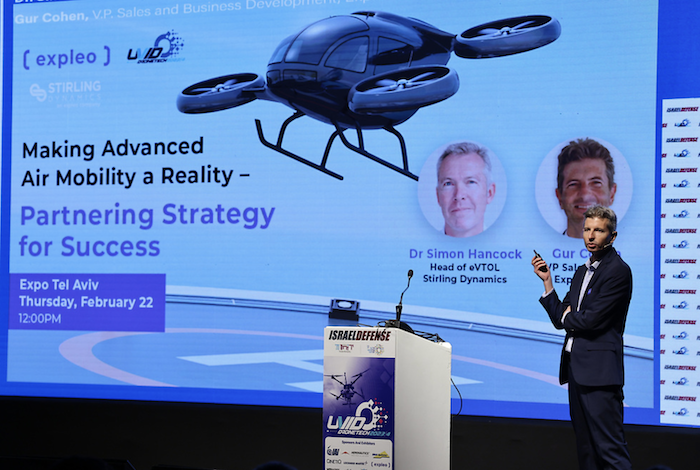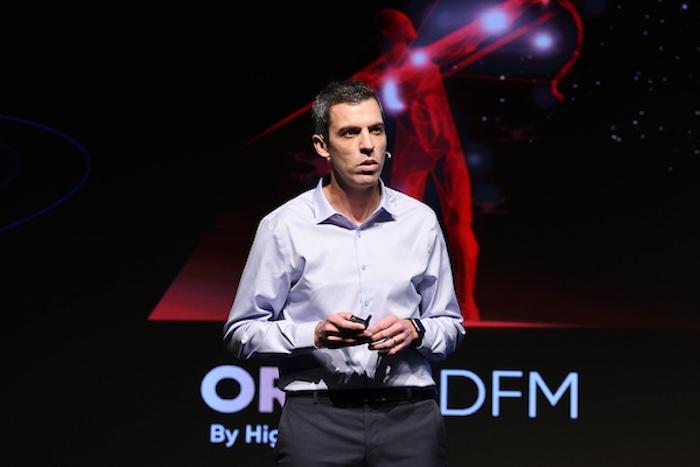UVID Dronetech 2024: The Evolution of Advanced and Unmanned Civil Aviation
From engineering and regulation challenges to a brand new ecosystem and the changing position of the human factor
Mandi Kogosowski
|
22/02/2024
Making advanced air mobility a reality: Dr. Simon Hancock, Head of eVOL, Expleo Group – Stirling Dynamics UK, spoke remotely at the UVID Dronetech conference held in Tel Aviv this morning, about the major steps taken in this realm.
“We’re really starting from zero, learning to create lots of new technologies that haven’t existed before,” Hancock said, when comparing air mobility tech to the conventional models of passenger aircraft. He referred to various challenges: mechanic, electrical, aerodynamic, software and electronics, modeling and simulation, and more, posing the question of how they can all be tackled with no prior experience and no preexisting models to draw from or lean on.
Hancock also referred to the challenges of scale in terms of people, the process, and manufacturing, as well as to new regulations and air traffic considerations that must be taken into account.

Gur Cohen, VP, Sales and Business Development at Expleo Group, discussed the company’s ability to provide engineering solutions to all relevant problems. “If there is an engineering challenge you are facing these days – please come see us,” he said.
Alon Abelson, CEO & Co-Founder at High Lander, spoke about the evolution of aviation and how to manage air traffic in the digital airspace.
“Have we really brought the aviation world to the edge? Is air travel really accessible?” Abelson asked, and answered: “For most of us, the road is still king. 90% of traffic is conducted in vehicles.” Abelson discussed the previous attempts to separate ground and air traffic and the shifts in this paradigm, noting that thanks to the evolving overlap, air traffic and UAV traffic can grow and expand.
For the first time in history, UAV technology has opened the possibility of flight to anyone and everyone – for personal use, commercial, military, intelligence, and more. High Lander creates solutions that drone users to use this new technology easily and safely, regardless of past experience, while providing authorities with the tools to manage all of this new air traffic safely.
Abelson spoke about the help provided by drones on October 7th, following Hamas’ brutal surprise attack, where many communities along the Gaza border launched drones in the air for defense, surveillance, and data-gathering purposes. This is something never done before in such a scope.

Alon Abelson
More than 70% of air accidents occur due to the human factor, Abelson said, adding that the more autonomous aircraft technology develops – the less one will need to rely on the human factor. “The technology that gave us wings will take us to the next phase of air mobility, and as technology companies, we must enable this,” he concluded.
Dekel Noyhous, VP of Business Development at AGL, spoke about human-machine balance in airspace management, in a lecture called “The human pulse in a digital sky.” He referred to Abelson’s thesis of “no humans in the loop,” saying that “we are not there yet, but we’ll get there, it’s an evolution process. Just like any new process, there is quite a bit of uncertainty here.”
The vision, according to Noyhous, is an ecosystem that relies on automation. However, the human factor is still in the loop – a person who can always examine the situation and think of problems as solutions, as part of this new ecosystem. “We’re in the very first phases of this new ecosystem evolution, and it will take quite a bit of time,” Noyhous said.
So what will be the new job of the human factor? People, according to Noyhous, will be “U-space supervisors,” there to solve complex problems and issues. They must have the proper background and training to manage their environments. “In the near future, all blockages will be removed, and then it must be necessary to examine the human factor’s position within this realm,” he concluded.
From engineering and regulation challenges to a brand new ecosystem and the changing position of the human factor
Making advanced air mobility a reality: Dr. Simon Hancock, Head of eVOL, Expleo Group – Stirling Dynamics UK, spoke remotely at the UVID Dronetech conference held in Tel Aviv this morning, about the major steps taken in this realm.
“We’re really starting from zero, learning to create lots of new technologies that haven’t existed before,” Hancock said, when comparing air mobility tech to the conventional models of passenger aircraft. He referred to various challenges: mechanic, electrical, aerodynamic, software and electronics, modeling and simulation, and more, posing the question of how they can all be tackled with no prior experience and no preexisting models to draw from or lean on.
Hancock also referred to the challenges of scale in terms of people, the process, and manufacturing, as well as to new regulations and air traffic considerations that must be taken into account.

Gur Cohen, VP, Sales and Business Development at Expleo Group, discussed the company’s ability to provide engineering solutions to all relevant problems. “If there is an engineering challenge you are facing these days – please come see us,” he said.
Alon Abelson, CEO & Co-Founder at High Lander, spoke about the evolution of aviation and how to manage air traffic in the digital airspace.
“Have we really brought the aviation world to the edge? Is air travel really accessible?” Abelson asked, and answered: “For most of us, the road is still king. 90% of traffic is conducted in vehicles.” Abelson discussed the previous attempts to separate ground and air traffic and the shifts in this paradigm, noting that thanks to the evolving overlap, air traffic and UAV traffic can grow and expand.
For the first time in history, UAV technology has opened the possibility of flight to anyone and everyone – for personal use, commercial, military, intelligence, and more. High Lander creates solutions that drone users to use this new technology easily and safely, regardless of past experience, while providing authorities with the tools to manage all of this new air traffic safely.
Abelson spoke about the help provided by drones on October 7th, following Hamas’ brutal surprise attack, where many communities along the Gaza border launched drones in the air for defense, surveillance, and data-gathering purposes. This is something never done before in such a scope.

Alon Abelson
More than 70% of air accidents occur due to the human factor, Abelson said, adding that the more autonomous aircraft technology develops – the less one will need to rely on the human factor. “The technology that gave us wings will take us to the next phase of air mobility, and as technology companies, we must enable this,” he concluded.
Dekel Noyhous, VP of Business Development at AGL, spoke about human-machine balance in airspace management, in a lecture called “The human pulse in a digital sky.” He referred to Abelson’s thesis of “no humans in the loop,” saying that “we are not there yet, but we’ll get there, it’s an evolution process. Just like any new process, there is quite a bit of uncertainty here.”
The vision, according to Noyhous, is an ecosystem that relies on automation. However, the human factor is still in the loop – a person who can always examine the situation and think of problems as solutions, as part of this new ecosystem. “We’re in the very first phases of this new ecosystem evolution, and it will take quite a bit of time,” Noyhous said.
So what will be the new job of the human factor? People, according to Noyhous, will be “U-space supervisors,” there to solve complex problems and issues. They must have the proper background and training to manage their environments. “In the near future, all blockages will be removed, and then it must be necessary to examine the human factor’s position within this realm,” he concluded.



